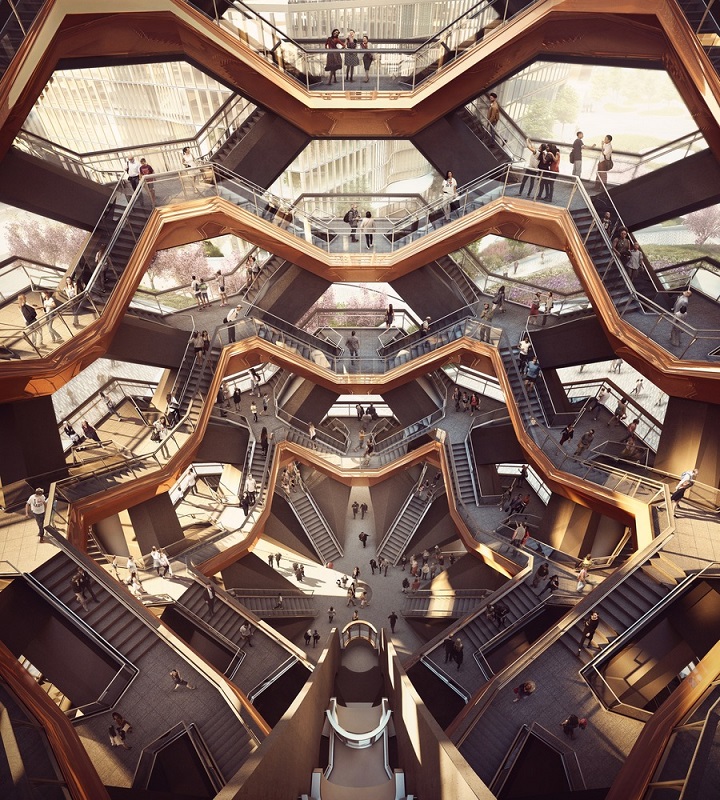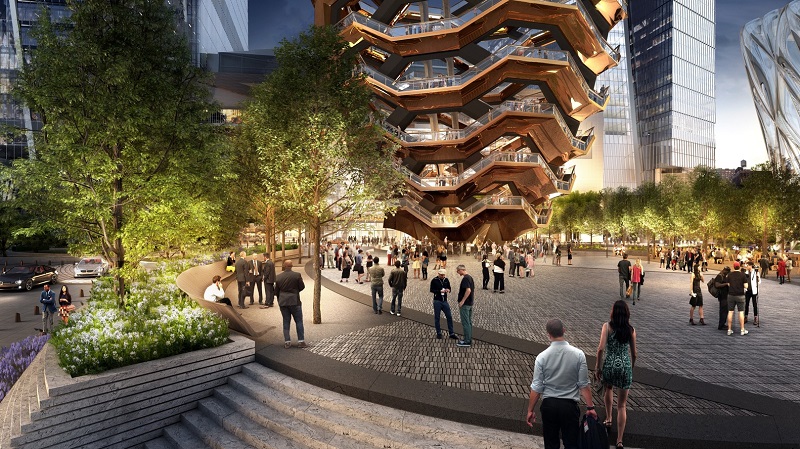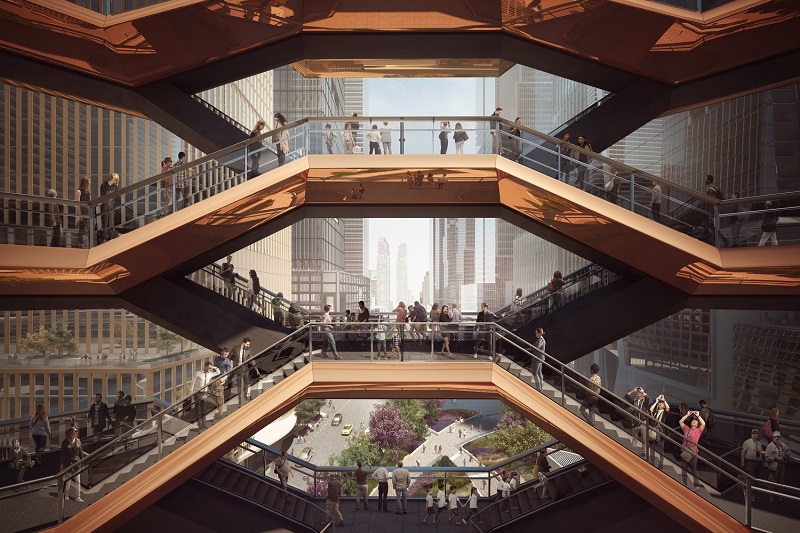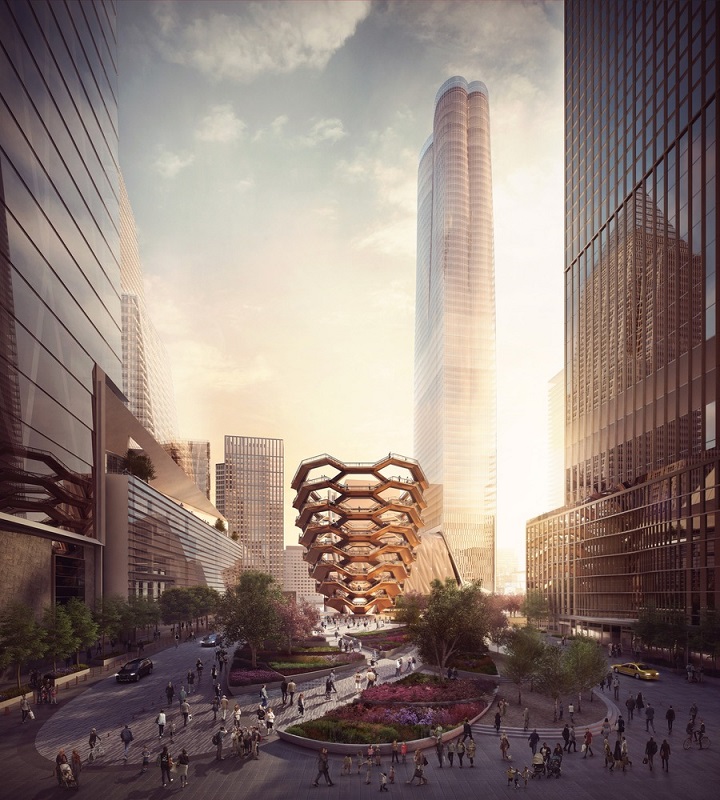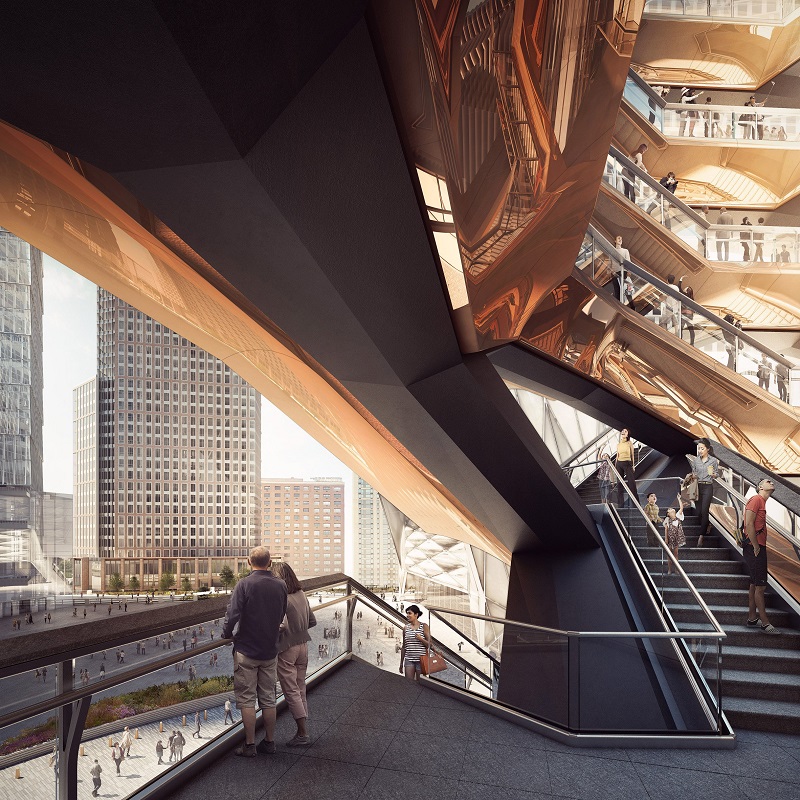Vessel, New York
Contents |
[edit] Designs
In September 2016, British architect-designer Thomas Heatherwick unveiled the first renderings of a new public monument for New York City.
Vessel is a sculpture standing 15-storeys high, consisting of 154 intricately interconnecting flights of stairs. Sitting in a public plaza and gardens, it will form the centrepiece of west Manhattan’s new Hudson Yards development, the city’s largest urban development since the Rockefeller Center in the 1930s.
Heatherwick said Vessel’s lattice was inspired by the geometries of Indian stepwells, and is made up of almost 2,500 individual steps and 80 landings. Weighing 600 tons, each layer of the hexagonal structure becomes wider, from a 15 m (50 ft) diameter at the base to 46 m (150 ft) at the top, forming a conical shape.
The structural steel frame will be clad in a polished copper-coloured steel skin, providing warped reflections of the plaza below.
Vessel’s cost has escalated from the original budget of $75m to an estimate of $150m. Some of the elements are currently under construction in Italy but are not to be assembled on site until 2017.
Heatherwick said: “My studio was commissioned to design a centrepiece for an unusual new piece of land in New York. In a city full of eye-catching structures, our first thought was that it shouldn’t just be something to look at. Instead we wanted to make something that everybody could use, touch, relate to.
“When I was a student, I fell in love with an old discarded flight of wooden stairs outside a local building site. It caught my imagination and I loved that is was part furniture and part infrastructure. You could climb up stairs, jump on them, dance on them, get tired on them and then plonk yourself down on them.
“Years later, suddenly here was an opportunity to make a new kind of landmark for Hudson Yards. We wondered whether it could be built entirely from steps and landings?”
[edit] Construction
In April 2017, construction officially began on Vessel. 75 individual units are to be prefabricated by Cimolai S.p.A in their Italian facility before being shipped to New York and assembled on site.
Ten pieces were already in New York as of April, with the remainders being scheduled to arrive and be assembled over the course of 2017.
In December 2017, Vessel topped out after eight months of construction, well ahead of its scheduled opening along with the whole Public Square and Gardens in autumn of 2018.
Over the course of 2018, the final mechanical and safety components will be installed, as well as the surrounding landscaping designed by designed by Nelson Byrd Woltz Landscape Architects in collaboration with Heatherwick Studio.
Upon completion, the public square will house more than 8,000 plants and 200 mature trees, including a wide variety of woodland plants and perennial gardens, as well as a 200 ft-long fountain that will mirror the flow of a river.
Thomas Heatherwick said:
“Vessel is one of the most complex pieces of steelwork ever made. Today we are marking the exciting moment when the last of the enormous 75 pre-fabricated pieces which travelled all the way from Italy to Manhattan, has been assembled ahead of schedule and with astonishing geometric accuracy. Over the next few months we’ll focus on installing the final details of the structure, as its paving, balustrades, lighting and cladding come together to complete this different kind of public space.”
Images and content courtesy of Forbes Massie-Heatherwick Studio.
[edit] Find out more
[edit] Related articles on Designing Buildings Wiki
Featured articles and news
RTPI leader to become new CIOB Chief Executive Officer
Dr Victoria Hills MRTPI, FICE to take over after Caroline Gumble’s departure.
Social and affordable housing, a long term plan for delivery
The “Delivering a Decade of Renewal for Social and Affordable Housing” strategy sets out future path.
A change to adoptive architecture
Effects of global weather warming on architectural detailing, material choice and human interaction.
The proposed publicly owned and backed subsidiary of Homes England, to facilitate new homes.
How big is the problem and what can we do to mitigate the effects?
Overheating guidance and tools for building designers
A number of cool guides to help with the heat.
The UK's Modern Industrial Strategy: A 10 year plan
Previous consultation criticism, current key elements and general support with some persisting reservations.
Building Safety Regulator reforms
New roles, new staff and a new fast track service pave the way for a single construction regulator.
Architectural Technologist CPDs and Communications
CIAT CPD… and how you can do it!
Cooling centres and cool spaces
Managing extreme heat in cities by directing the public to places for heat stress relief and water sources.
Winter gardens: A brief history and warm variations
Extending the season with glass in different forms and terms.
Restoring Great Yarmouth's Winter Gardens
Transforming one of the least sustainable constructions imaginable.
Construction Skills Mission Board launch sector drive
Newly formed government and industry collaboration set strategy for recruiting an additional 100,000 construction workers a year.
New Architects Code comes into effect in September 2025
ARB Architects Code of Conduct and Practice available with ongoing consultation regarding guidance.
Welsh Skills Body (Medr) launches ambitious plan
The new skills body brings together funding and regulation of tertiary education and research for the devolved nation.
Paul Gandy FCIOB announced as next CIOB President
Former Tilbury Douglas CEO takes helm.
UK Infrastructure: A 10 Year Strategy. In brief with reactions
With the National Infrastructure and Service Transformation Authority (NISTA).






